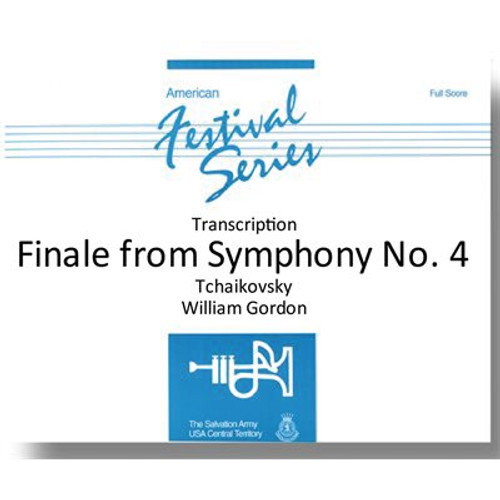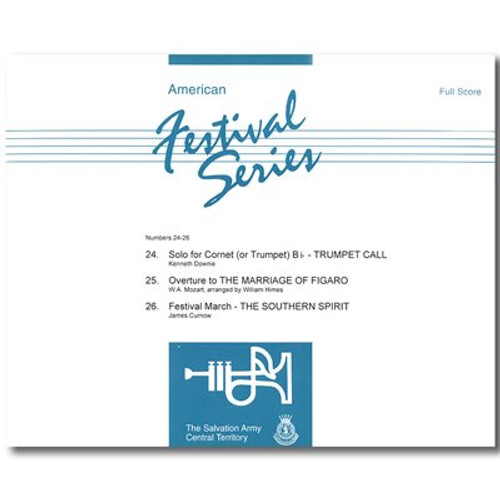Product Description
American Festival Series - Special Edition
63. FINALE from Symphony No. 4
Tchaikovsky, arranged by William Gordon
Brian Bowen, Editor
Dr. Harold Burgmayer, Music Secretary, USA Central Territory
Program Note:Instrumentation
Tchaikovsky composed the fourth of his six symphonies in 1877, and it was premiered in 1878 in Moscow. The exciting Finale movement with its swirling scales, folk song-like motifs and extended crescendos remains an audience favorite. One high-point of the Finale is the dramatic reentry of the opening trumpet fanfare form the first movement, which subsides to a near standstill, and then ignites into the exciting conclusion. We are grateful to William Gordon for this fine transcription for brass band.
Note to the Conductor:
Beginning to bar 9: A measured, yet fiery tempo should be established from the outset, punctuated by percussion. Note that two percussion parts are provided. Percussion 1 is exclusively for timpani, while percussion 2 includes essential parts for crash cymbals, bass drum and triangle. In the event that an additional percussionist is available, optional snare drum notations are included on the Percussion 2 part. At bar 9, the trombones emulate French horns with accented half notes in octaves. Trombones should move to the background by bar 10.
Bars 10-37: The main motif of this movement commences in flugel and baritones at bar 10, with its simple descending scale pattern. Throughout the piece, a slight stress should be given to appoggiaturas, like the one on the downbeat of bar 12. The basses should imitate the light pizzicato of cellos and basses. At first, this is in unison, but by bar 14 there are independent rhythms between the Eb and Bb basses which should dovetail together as a composite whole. The solo cornet and solo euphonium figuration, commencing at bar 11, should be light and controlled. By bar 18, Tchaikovsky abandons the descending scale figures for an appoggiatura on the downbeat of each measure, accompanied by an increase in the frequency of the cornet and euphonium figuration. Build tension with the crescendo at bar 22 to give way to a balanced exchange of descending scales, climaxing in a return to the fiery opening at bar 30. Note that there are differences from the opening bars (compare bar 3 with bar 26), and in the insertion of orchestral trumpet and trombone eighth-note octaves in bars 30 and 34.
Bars 38-59: Commencing at bar 38, the downbeat accent across the entire ensemble is essential to the forward motion of the piece. At bar 46, there is a sudden drop in volume to mezzo piano (and a reduction of players) with a quick crescendo to an intense tutti section at bar 47. The crash cymbals are vital to the overall effect of this climactic section. Work for unified, measured dotted eighth and sixteenth patterns across the entire ensemble. The triplets introduced at bar 51 should be light and only mezzo forte in volume, giving way to full-bodied ascending third patterns from bar 56. There is no altering of tempo moving into bars 58-59 concluding with the two quick martellato chords followed by a sudden stop after the percussion shot on the "and" of beat four.
Bars 60-83: Following the grand pause, a contrast in style and tempo is called for at bar 60. The descending scalic motif is brought back, now with an altered articulation. There should be a subtle rise and fall in dynamics over the two-bar phrase. Give both length and space to the initial four eighth notes, and a light stress to the downbeat appoggiatura on the next bar. The accompanying chords should be very broad, yet never heavy.
Bars 84-109: At bar 84, an accelerando over four bars to the original tempo sets up an antiphonal exchange between the upper and lower parts of the band. The accented third beat half notes in trombones and 2nd cornet may sound almost as fortepiano chords. By bar 92, the exchanges re sixteenth notes have been telescoped closing together, expanding between octaves and must maintain steady tempo. From bar 92, make sure the exchange of quarter notes chords in pairs are solidly accented. At bar 98, the descending scaling motif requires a more muscular approach, commencing in trombones and basses, answered in a similar bold fashion beginning at bar 101 by the upper portion of the band.
Bars 110-133: A rallentando leads to the dramatic statement from the opening of the first movement, marked at a slower andante tempo at bar 110. The crash cymbal is essential and the chords underneath the horns an cornets "trumpeting" should be broad and sonorous. Noe the sudden drop in volume to mezzo forte in bar 114, and the subsequent crescendo leading to the climatic chord, which includes full percussion at bar 116. The combination of horns, baritones and trombones seeks to emulate the orchestral horn section at bar 119 and follow. Careful tuning between the octaves is requires from bar 125 to the pianissimo transition into Tempo I at bar 134.
Bar 134-end: At bar 134, an extended timpani roll, commencing pianissimo, supports the quiet exchanges for the accented dotted pattern first introduced at bar 38. Keep a steady rhythm, while creating an exciting build-up. The dotted rhythms give way to antiphonal exchanges of eighth notes at bar 148, which needs to preserve a steady pulse. A return of the antiphonal descending scales at bar 156 signals a reprise of the opening music at bar 160, this time with supporting "trumpets and trombones" in triplet rhythm. maintaining tempo and rhythmic drive is paramount. This can be difficult, especially between bars 175 and 176, and as the band approaches the tutti syncopation at bar 177. Only the cymbal player and the conductor are on the beat through those 2 bars. Note the dramatic drop in volume to mezzo forte and subsequent crescendo at bar 186, as the band simultaneously accelerates into the quicker vivace at bar 188. There is a subito mezzo forte at bar 192, which is followed by a crescendo. Also, maintain a controlled mezzo forte over bars 198-199 before the crescendo to the exciting concluding bars.
Instrumentation
(Optional transpositions in parenthesis)
| Full Score | |
| Eb Soprano | 2nd Baritone |
| Solo Cornet | 1st Trombone (B.C.) |
| 1st Cornet | 2nd Trombone (B.C.) |
| 2nd Cornet | Bass Trombone |
| Flugel Horn | Euphonium (B.C.) |
| Solo Horn | Eb Bass |
| 1st Horn | Bb Bass (B.C.) |
| 2nd Horn | Percussion 1 - Timpani |
| 1st Baritone | Percussion 2 - Crash Cyms., B.D., S.D., Triangle |









